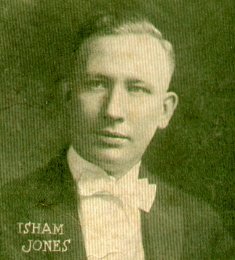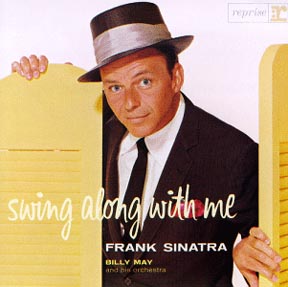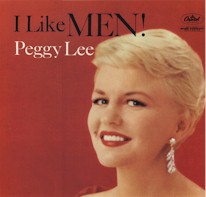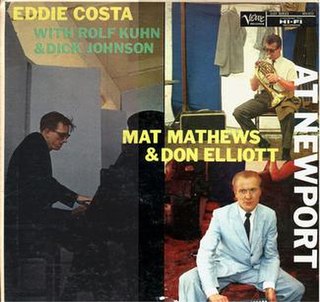Related Research Articles

This is a list of notable events in music that took place in the year 1925.

Isham Edgar Jones was an American bandleader, saxophonist, bassist and songwriter.

Gustav Gerson Kahn was an American lyricist who contributed a number of songs to the Great American Songbook, including "Pretty Baby", "Ain't We Got Fun?", "Carolina in the Morning", "Toot, Toot, Tootsie ", "My Buddy" "I'll See You in My Dreams", "It Had to Be You", "Yes Sir, That's My Baby", "Love Me or Leave Me", "Makin' Whoopee", "My Baby Just Cares for Me", "I'm Through with Love", "Dream a Little Dream of Me" and "You Stepped Out of a Dream".

Ol' Yellow Eyes Is Back is an album by Brent Spiner, best known for his role as Data in the American television series Star Trek: The Next Generation, first released in June 1991. The title is a parodic reference both to Frank Sinatra's Ol' Blue Eyes Is Back and the Data character, whose eyes are golden yellow. On the album, Spiner is backed by the orchestra from that series as he sings a number of old pop standards, mostly from the 1930s and 1940s.

"Shine On, Harvest Moon" is a popular early-1900s song credited to the married vaudeville team Nora Bayes and Jack Norworth. It was one of a series of moon-related Tin Pan Alley songs of the era. The song was debuted by Bayes and Norworth in the Ziegfeld Follies of 1908 to great acclaim. It became a pop standard, and continues to be performed and recorded in the 21st century.
"Pretty Baby" is a song written by Tony Jackson during the Ragtime era. The song was remembered as being prominent in Jackson's repertory before he left New Orleans in 1912, but was not published until 1916.

Sinatra Swings is an album by Frank Sinatra with Billy May and his Orchestra, released in 1961.

Theodore Salvatore Fiorito, known professionally as Ted Fio Rito, was an American composer, orchestra leader, and keyboardist, on both the piano and the Hammond organ, who was popular on national radio broadcasts in the 1920s and 1930s. His name is sometimes given as Ted Fiorito or Ted FioRito.

"You'd Be Surprised" is a song written by Irving Berlin in 1919 which Eddie Cantor interpolated it into Ziegfeld's Follies of 1919. Cantor soon recorded it and it became a major hit. Other popular versions in 1920 were by the All-Star Trio and by Irving Kaufman.

"Yes Sir, That's My Baby" is a popular U.S. song from 1925. The music was written by Walter Donaldson and the lyrics by Gus Kahn. It is now in the public domain.

I Like Men! is a 1959 studio album recorded by Peggy Lee, arranged and conducted by Jack Marshall.

Personal Appearance is a 1957 album by Sonny Stitt.
"My Little Grass Shack in Kealakekua, Hawaiʻi", written by Tommy Harrison, Bill Cogswell, and Johnny Noble in Hawaii in 1933, is a Hawaiian song in the Hawaiian musical style known as hapa haole. One of the earliest recordings by Ted Fio Rito and his orchestra reached number one on the charts in 1934. Honolulu magazine listed it as number 41 in a 2007 article, "50 Greatest Songs of Hawaii". It has been heard in many movies and television shows and has been covered dozens of times. The title is sometimes shortened to "My Little Grass Shack" or "Little Grass Shack".

36 Greatest Hits! is a 2010 box set by American singer Frank Sinatra. This box set consists 36 songs he recorded for his own label, Reprise.

My Heart Sings is an album by American singer Tony Bennett. It was recorded in 1961 and released the same year on Columbia as CL 1658. So far, it has been released on CD only in Japan by Sony/CBS.

12! is an album by saxophonist Sonny Stitt recorded in 1972 and released on the Muse label.

Boy with Lots of Brass is a 1957 album by Canadian jazz trumpeter Maynard Ferguson featuring singer Irene Kral.

Eddie Costa, Mat Mathews & Don Elliott at Newport is a live album featuring performances by Eddie Costa's Trio/Quintet, Mat Mathews' Quartet and Don Elliott's Quartet recorded at the Newport Jazz Festival in 1957 and released on the Verve label.

Jazz of Two Cities, is an album by saxophonist Warne Marsh recorded in 1956 and originally released on the Imperial label. The album was later released in stereo as The Winds of Marsh which featured different takes of four of the numbers.

Toot, Toot, Tootsie is a 1922 song with music and lyrics by Gus Kahn, Ernie Erdman and Danny Russo, per the credits on the original sheet music cover. Some other sources also credit Ted Fio Rito and Robert King for the song, but make no mention of Dan Russo. It debuted in the Broadway musical Bombo, where it was a major hit. It was first recorded by Al Jolson with Frank Crumit's orchestra for Columbia Records on September 9, 1922. It was further popularised by the racy singer-comedian Eddie Cantor.
References
- ↑ Tyler, Don (2007). Hit Songs, 1900-1955: American Popular Music of the Pre-Rock Era. McFarland. p. 132. ISBN 9780786429462 . Retrieved 5 March 2018.
- ↑ Fiorito, Ted; Kahn, Gus. "Charley, my boy [music] / [words] by Gus Kahn ; & [music by] Ted Fiorito". National Library of Australia Catalogue. J. Albert & Son. Archived from the original on March 3, 2016.
- ↑ "Charley, My Boy by Eddie Cantor". secondhandsongs.com. Retrieved 5 March 2018.
- ↑ "Charley My Boy", Stanford University
- ↑ Radio Theme List, ClassicThemes.Com
- ↑ "Charley My Boy" Archived July 18, 2011, at the Wayback Machine , Cedar.net square dance calls